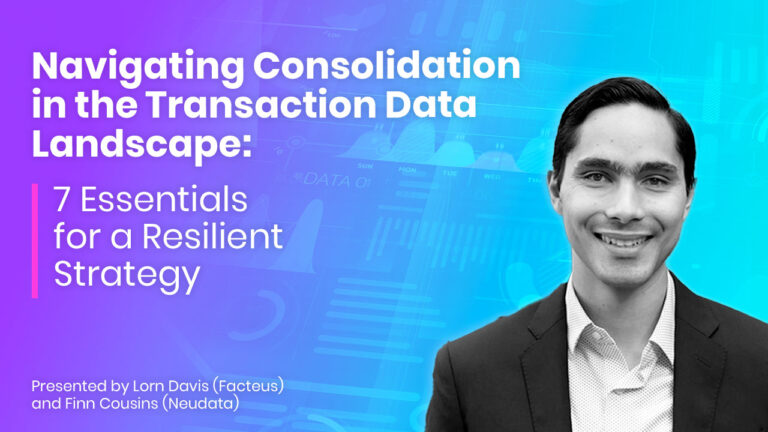Learn about key considerations and use cases for alternative data.
Real World Uses
Key Considerations
Getting Started
The world doesn’t wait for quarterly earnings. Consumers change behavior overnight. Businesses pivot in weeks, not years. And yet, most decision-makers are still flying blind, relying on reports that summarize what happened weeks or months ago. That’s a dangerous position in a world that rewards agility and punishes lag.
Enter alternative data—the new frontier of visibility. It’s how hedge funds spot demand shifts before earnings. How finance leaders forecast with precision. How marketers find signals amid noise. And increasingly, how AI builders train systems that understand the world as it’s unfolding, not as it once was. Alternative data is not some emerging novelty. It’s becoming the core substrate of modern decision-making.
Doug Scott, a former Point72 portfolio manager, put it this way:
“The only edge left is speed—and speed requires better inputs. If you’re not ingesting real-world behavior, you’re building blind.”
But here’s the truth: not all alternative data is created equal. Some datasets hint at behavior. Others model it. But only one reflects it directly: transaction data.
Transaction data shows what people and businesses are doing with their money. Not what they say, not what they search, not where they went—but what they actually bought.
Example: Consumer Spend by Sector:
Total Sector Spending
| Jan '25 | Feb '25 | Mar '25 | Apr '25 | May '25 | Jun '25 | |
|---|---|---|---|---|---|---|
| Retail Sales ex. Auto | 4.74% | -1.91% | 0.65% | 6.56% | 2.45% | -0.03% |
| Building mat. and garden equip. and supplies dealers | 0.17% | -6.12% | 0.31% | 3.03% | 3.25% | -6.08% |
| Clothing and clothing access. stores | -3.28% | -2.05% | 0.46% | 3.88% | 2.27% | 0.35% |
| Electronics and appliance stores | -5.71% | -4.82% | -0.80% | 11.68% | -13.93% | -1.76% |
| Food and beverage stores | 3.83% | -0.33% | -2.34% | 8.07% | 3.15% | -0.58% |
| Food services and drinking places | 4.00% | -0.91% | 1.79% | 6.45% | 7.73% | 0.47% |
| Furniture and home furnishings stores | 4.21% | -2.50% | 9.40% | 6.06% | 5.79% | 6.06% |
| Gasoline stations | 1.21% | -4.69% | -6.42% | -2.37% | -6.16% | -4.37% |
| General merchandise stores | 2.73% | 0.02% | 0.87% | 4.85% | 3.13% | 1.90% |
| Health and personal care stores | 11.47% | -2.70% | 1.66% | 11.26% | 6.36% | 3.85% |
| Miscellaneous store retailers | 4.83% | 2.22% | 7.15% | 6.93% | -6.48% | -5.98% |
| Nonstore retailers | 11.72% | -1.66% | 5.70% | 8.62% | 3.74% | 1.95% |
| Sporting goods, hobby, musical instrument, and book stores | -2.69% | -6.23% | -4.08% | 4.43% | 1.12% | -0.26% |
And that’s why transaction data has become the gold standard. It’s the cleanest signal for those building models, managing risk, allocating capital, and optimizing performance. This guide breaks down what alternative data really means, why transaction data is its most valuable form, and how organizations are putting it to work—whether in hedge funds, corporate finance, marketing, or product strategy.
Alternative Data at a Glance
Alternative data refers to non-traditional datasets—like transaction activity, satellite imagery, or web scraping—that provide real-time visibility into consumer and business behavior. These signals are increasingly used by investors, operators, marketers, and AI builders to make faster, more informed decisions.
WHO USES IT?
- Quantitative hedge funds and investors
- Corporate finance and FP&A teams
- AdTech platforms and media agencies
- Marketing and product strategy leaders
- AI and ML teams training on real-world signals
WHY IT MATTERS
- Speeds up reaction time
- Surfaces behavior before it shows up in earnings
- Replaces assumptions with truth
- Powers smarter planning, allocation, and execution
What is Alternative Data?
Alternative data refers to non-traditional datasets that provide insight into economic activity, consumer behavior, and market dynamics. While traditional data sources like earnings reports are static and delayed, alternative data reflects the real economy in motion.
Common Types of Alternative Data:
Web-scraped data
Includes information pulled from websites—product prices, inventory levels, customer reviews, and job postings. This type of data is useful for tracking price changes across competitors, monitoring stock availability during promotions, and analyzing hiring patterns to anticipate company expansion. However, its reliability depends on how cleanly it’s captured and how frequently it’s updated.
Social media sentiment
Offers a window into how consumers feel about brands and products. By analyzing posts, comments, and likes across platforms like X, Reddit, and Instagram, companies can glean public opinion trends. It’s especially useful for crisis detection or product launch feedback, but it’s highly volatile and often skewed by small sample sizes or bot activity.
Satellite imagery
Provides visual indicators of economic activity. Analysts use it to track construction progress, estimate agricultural yield, or measure parking lot traffic at retail stores. While insightful for large-scale trends, it lacks granularity and may lag behind real-time developments due to satellite revisit times.
Geolocation data
Captures movement patterns through mobile devices. It helps track footfall around stores, measure dwell time, and understand regional mobility trends. Retailers use it to analyze the effectiveness of store placements or assess the impact of external events like weather or local closures. Yet without context, location data doesn’t reveal intent or outcome.
Mobile app usage data
Shows how users interact with digital platforms—session frequency, time spent, engagement depth, and uninstall rates. App developers and digital marketers use it to understand churn behavior and feature performance. Still, it tells you what users did on the app, not whether that translated to an actual sale.
The Gold Standard: Transaction Data
Consumer purchase behavior comes from anonymized credit and debit card swipes. It shows what people actually spent their money on, where, and when. Unlike surveys or location data, there’s no guessing—just verified outcomes. It’s the best early signal of demand shifts, promotional lift, or brand loyalty erosion.
Example: Consumer Purchase Behavior:
Total Consumer Spending
Year-over-year growth in retail sales excluding auto
Durable vs Non-Durable Goods
Comparison of durable and non-durable goods performance
See Real Outcomes, Not Just Signals
Use Cases by Role
Quantitative Investors
Quantitative hedge funds rely on transaction-level data to construct predictive models, identify early inflection points, and optimize risk exposure. Rather than depending on quarterly earnings or consensus revisions, quants using Facteus data can detect real-time behavioral shifts—such as a spike in QSR spend linked to a limited-time promotion or a deceleration in electronics purchases suggesting demand softness.
For model builders, SKU-level transaction data provides clean, granular variables that plug directly into alpha factor libraries. These data points can enhance momentum, reversal, or seasonal strategies by tying real consumer spend to brand- or category-level trends. And because Facteus data updates with just a two-day lag, quants can test and trade signals before they decay—ensuring greater precision and less noise.
In portfolio construction, managers use this data to validate long/short baskets, monitor exposure to macro or sector risk, and detect crowding or divergence. Whether you’re managing a thematic book or sector-neutral strategy, Facteus gives you visibility into how people are actually spending—by merchant, channel, and geography.
FP&A and Finance Leaders
Finance executives in retail, QSR, and consumer goods rely on transaction data to sharpen their financial planning and analysis. With real-time visibility into competitor and category performance, FP&A leaders can replace spreadsheet assumptions with actual benchmarks. For example, if your brand’s Midwest sales are up 4% but the regional category is growing 8%, you know you’re losing share—fast enough to adjust plans.
Transaction data also enables dynamic forecasting. Rather than waiting for internal POS consolidation or vendor-lagging indicators, finance teams use SKU-level and regional data to spot category contractions, promotional lift decay, or seasonal anomalies. This improves planning accuracy and allows for real-time course correction.
Scenario modeling becomes more robust too. Using Facteus data, teams can simulate what inflationary pressures, regional slowdowns, or channel shifts would do to category performance—grounding your budget assumptions in what’s actually happening across the market, not just your brand.
AdTech Platforms & Agencies
Transaction data is a game-changer for agencies and advertising technology platforms seeking to personalize campaigns and prove ROI. Facteus enables activation of audiences based on verified purchase behavior, not inferred intent. Want to target frequent coffee shop visitors or buyers of luxury skincare in the last 30 days? We’ve got you covered—with monthly-updated, privacy-safe segments.
Syndicated audiences are prebuilt and ready to use across platforms like The Trade Desk, while custom segments can be generated within 24–48 hours. These custom segments allow agencies to win new business by showing pitch prospects a live, category-specific shopper profile—and then measuring outcomes using actual card spend.
When it comes to measurement, Facteus eliminates guesswork. Agencies no longer have to rely on exposed-vs-control surveys or panel modeling. With Facteus, they can quantify spend before, during, and after a campaign at the merchant, brand, or category level—proving real incremental lift, not just impressions or CTRs.
Marketers & Strategy Teams
For CMOs, brand directors, and growth strategists, transaction data turns fuzzy KPIs into concrete answers. Did your product launch grow net new category volume or simply steal share from a sister SKU? Is your in-store channel outperforming e-commerce, or vice versa? How did your brand do versus direct and indirect competitors last quarter?
Facteus allows marketers to answer these questions with hard numbers. Teams can track SKU-level performance across geographies, see wallet share shifts, and understand shopper journeys—such as which brands customers visited before and after purchasing from you.
Promotional analysis also becomes smarter. You can isolate whether a campaign drove true incremental revenue or just pulled demand forward. And with daily data, you can make in-flight optimizations—not just post-mortems.
Ultimately, it transforms strategy from intuition to instrumentation—grounding your growth bets in real-world economic behavior.
Why Facteus Leads in Transaction Data
While others sell scraped data or modeled assumptions, Facteus delivers anonymized, permissioned transaction data at scale. Our platform provides:
- Billions in card transactions, updated on a 2-day lag
- SKU-level receipts across retail, QSR, travel, and more
- B2B invoice-level data for industrial and wholesale use cases
- Full compliance with CCPA, GDPR, and ISO security standards
- APIs and dashboards built for quants, marketers, and analysts
We don’t offer inference. We offer confirmation.
Total Sector Spending
| Jan '25 | Feb '25 | Mar '25 | Apr '25 | May '25 | Jun '25 | |
|---|---|---|---|---|---|---|
| Retail Sales ex. Auto | 4.74% | -1.91% | 0.65% | 6.56% | 2.45% | -0.03% |
| Building mat. and garden equip. and supplies dealers | 0.17% | -6.12% | 0.31% | 3.03% | 3.25% | -6.08% |
| Clothing and clothing access. stores | -3.28% | -2.05% | 0.46% | 3.88% | 2.27% | 0.35% |
| Electronics and appliance stores | -5.71% | -4.82% | -0.80% | 11.68% | -13.93% | -1.76% |
| Food and beverage stores | 3.83% | -0.33% | -2.34% | 8.07% | 3.15% | -0.58% |
| Food services and drinking places | 4.00% | -0.91% | 1.79% | 6.45% | 7.73% | 0.47% |
| Furniture and home furnishings stores | 4.21% | -2.50% | 9.40% | 6.06% | 5.79% | 6.06% |
| Gasoline stations | 1.21% | -4.69% | -6.42% | -2.37% | -6.16% | -4.37% |
| General merchandise stores | 2.73% | 0.02% | 0.87% | 4.85% | 3.13% | 1.90% |
| Health and personal care stores | 11.47% | -2.70% | 1.66% | 11.26% | 6.36% | 3.85% |
| Miscellaneous store retailers | 4.83% | 2.22% | 7.15% | 6.93% | -6.48% | -5.98% |
| Nonstore retailers | 11.72% | -1.66% | 5.70% | 8.62% | 3.74% | 1.95% |
| Sporting goods, hobby, musical instrument, and book stores | -2.69% | -6.23% | -4.08% | 4.43% | 1.12% | -0.26% |
What to Watch Out For
While alternative data unlocks new visibility, it’s not without its risks—and being mindful of them ensures more signal, less noise:
Signal vs. Noise:
One of the biggest challenges in using alternative data is distinguishing true signal from random noise. A 3-day spike in QSR spend could indicate a meaningful shift in consumer demand—or it might just be the result of a localized promotion, sporting event, or weather disruption. Without context, these fluctuations can lead to false positives and bad decisions. To mitigate this, transaction data must be paired with category benchmarks, seasonal norms, and promotional overlays. Smart users look at persistence, volume consistency, and correlated indicators before reacting to any single surge in activity.
Overfitting in Models:
Alternative data—especially high-frequency data like transactions—can be a double-edged sword. With enough granularity, it becomes dangerously easy to build backtests that perform beautifully in hindsight but fail when applied in production. This is particularly true when data is overfit to specific promotions, regions, or timeframes. To avoid this trap, users should test signals across multiple time horizons, market regimes, and categories. Robust signals should hold under stress and generalize beyond the initial training set. Facteus customers often run parallel validations using 5-year historicals and out-of-sample periods to build durable edge.
Privacy & Compliance:
As the use of consumer-level data grows, so too does regulatory scrutiny. Not all alternative data sources are created equal—many web-scraped or inferred datasets walk a fine line in terms of privacy and consent. Transaction data, when properly anonymized and permissioned, can be both powerful and compliant. Facteus adheres to the highest data governance standards, including full CCPA and GDPR compliance. All data is de-identified, aggregated, and built with a privacy-first architecture that protects both the data subjects and the enterprise user.
Team Readiness:
Transitioning to alternative data—especially real-time behavioral data—requires more than a new feed. It demands new workflows, analytical thinking, and operational readiness. Teams used to static, backward-looking reports must adopt a mindset of continuous learning, iteration, and real-time response. That may mean restructuring dashboards, integrating data science into strategy, or upskilling analysts to think like signal interpreters. Organizations that succeed with alternative data don’t just ingest it—they rewire how they make decisions around it.
How to Get Started
Define your goal
Alpha generation? Forecast validation? Shopper segmentation?Request sample data
We’ll provide historical views to test signal strength or benchmark performance.Ingest live feeds
Get daily updates through dashboard, CSV, or real-time API.Optimize usage
Integrate into workflows—whether it’s quant models, forecast tools, or media platforms.Start Exploring
Final Takeaway
Alternative data comes in many forms—but only one kind gives you verified behavioral outcomes: transaction data. It’s the clearest, fastest, and most direct signal of what’s happening in the economy.
Facteus makes that signal accessible—whether you’re trading it, forecasting with it, or marketing against it.



